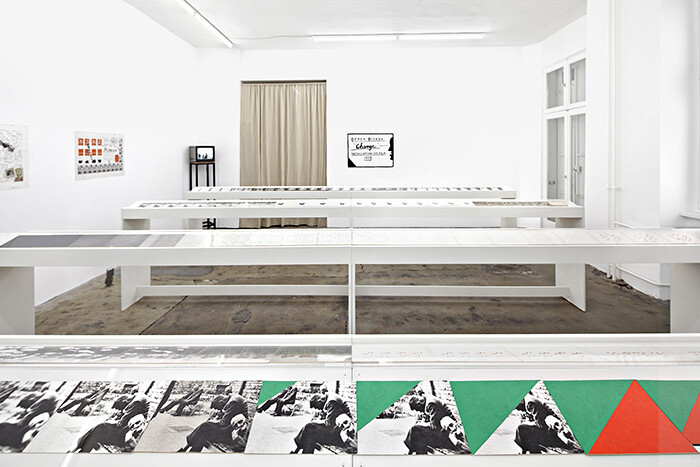Before it became a commercially viable mode of artistic production celebrating the hegemony of the market over the social, Pop was—albeit briefly—an art of critique. When popular mass culture motifs where first adopted by contemporary artists in the early-1950s, they seemed to announce a revival of Dadaism. For Eduardo Paolozzi, the Independent Group, and Richard Hamilton, photocollage—a technique Dada invented—was the main mode of Pop production.1
Emerging out of the horrors of trench warfare, Dada’s emphasis on rupture was not a mere aesthetic gimmick. Whereas the photographic montage commonly used in Victorian fantasy postcards fused all elements together to create an illusion of continuity, the Dadaist photocollages—which as Walter Benjamin noted, typically interrupted the context into which they were inserted2—made the artifice visible by fully displaying the sutures and cuts to which their images were subjected. Reciprocating the lacerations inflicted by mortars and barbed wire, photocollages make manifest that the present is composed of manifold irreconcilable states—that every actual thing is a tangible unity of opposed determinations.
Derek Boshier—whose current exhibition at Tanya Leighton Gallery constitutes his first solo show in Berlin—belongs specifically to a British Pop tradition, which is to say, his work is perhaps closer to that of contemporary British artists like Bruce McLean and Stephen Sutcliffe than to a spectrum of general Pop practices ranging from that of Jeff Koons to Takashi Murakami. Unlike their American counterparts, who swiftly moved away from the practice of juxtaposition to the acceptance of the given image as a compositional whole, British Pop artists maintained a Dadaist predilection for the partial and the fragmented, coupled with a critical attitude towards the sublation of working class experience into corporate culture. Whereas figures like Andy Warhol and Roy Lichtenstein monetized perishables by turning the transience of mass media flows into highbrow assets, British Pop—as exemplified by Boshier (born in 1937)—is best known for its assemblage of fragments in mixed-media prints, installations, and films. Providing a comprehensive view of his unfairly under-appreciated oeuvre, this extremely well-curated exhibition pairs the artist’s historical films with more recent work, like Best Foot Forward and Did You See… That? (both 2014).
One of the paradoxes of consumer culture is that—wholesomeness notwithstanding—its version of social integration is based on bodily disruption. The logic of advertisement severs the eye from the hand, commanding the viewer to look but not touch. Mobilizing avant-garde strategies, Reel (1973) is a film about scopophilia and partial objects—which, as Lacan noted, are never biologically given but always a product of the signifying order. Starting with a keyhole shot of a woman getting dressed in a bedroom, its true protagonist is not the woman or even her body, but a pair of glittery platform shoes. Traversing several locations—from polo grounds to the speakers’ corner, where a black man from Uganda is heckled for discussing colonial plunder—the silver-green platforms become stand-ins for the way class differences and political contradictions are provisionally obscured by the seduction of ritzy glamour and a lavish lifestyle. Reel is shown in tandem with another film, Link (1970), which parodies the tradition of sacred geometries and Platonic forms, expressed in the primary structures and geometric abstraction that constituted the formal lexicon of modern art from Constructivism to Minimalism. Link builds a chain of visual associations between semi-circles, domes, breasts, UFOs and the prisms, pyramids, and the open legs of a female model. In the diffuse world of post-Fordist economies, all images are mediated, and nothing circulates faster than money and female body parts—as the French collective Tiqqun wrote in their 1999 manifesto—the “Young-Girl” is a “war machine,” “the infantry” amongst “the troops occupying all visibility.”3
The gallery’s second exhibition space is devoted to the installation Change (1973) and its ancillary film. Spanning over 34 meters, a series of display cases featuring small drawings and collages criss-crosses the room. The sequence starts with a picture of the Royal Exchange in London surrounded by blots, which convert into the vast craters opened by WWII bombings, while the Royal Exchange itself transforms into a graphic depiction of a television set. In turn, the television set becomes a windowpane in the process of being replaced, and then turns into another blot that assumes the form of a small terrier whose owner is wearing the glittery platforms featured in Reel. The terrier, upon encountering a German Shepherd, morphs into yet another blot that happens to look like Johannesburg, and then finally metamorphoses into a police dog attacking a protester. Eventually, the picture peels away to reveal the navel and semi-open mouth of a female body. Graphic abstractions turn into Maoist red-stars. Richard Nixon sits on a couch. Nixon disappears, leaving an empty seat on a couch.
The above-mentioned “Young-Girl” is not a gendered concept, but a political subject, produced by the conflation of spectacle with the social. Boshier’s work—occasional legs and breasts aside—is clearly not about the former, but the latter: the new symbolic universe of market semiotics, which emerged in full force in the 1970s, its contradictory motives held together by financial flows, semi-open lips, and imperial power.
Dada adopted the term “photocollage” around 1918–19, in order to distinguish their politically oriented practice from the fantasy postcards so popular during the Victorian and Edwardian eras. The Pop movement allegedly originated in a lecture given by Paolozzi at the first Independent Group gathering, which consisted of a series of collages titled “Bunk!”
See Susan Buck-Morss, The Dialectics of Seeing: Walter Benjamin and the Arcades Project (Cambridge, Mass.: MIT Press, 1991), 67.
Tiqqun, Preliminary Materials for a Theory of the Young-Girl, trans. Ariana Reines, Semiotext(e)/Intervention Series #12 (Los Angeles: Semiotext(e), 2012): 105–106.










